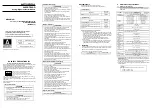
PVI 3000/4000/5000/5300
Installation
and Operation Manual
21
WARNING!
The National Electrical Code (NEC) states that the inverter must be connected to a dedicated circuit,
and that no other outlets or devices can be connected to the same circuit. The NEC also imposes
limitations on the size of the inverter and the manner in which it is connected to the utility gird.
WARNING!
Make sure that you use suitable conductors for both the AC and DC wiring. The cables must be
adequately sized and of correct temperature rating and sunlight resistant if needed. Use #10 AWG to
#6 AWG, 90
C (194
F) copper wire for all AC and DC wiring connections to the PVI
3000/4000/5000/5300 inverter.
WARNING!
PV arrays will be energized when exposed to light. Cover the arrays with opaque (dark) materials
during installation and wiring, and/or keep module leads disconnected.
Before wiring the PVI 3000-5300 inverter, the installer needs to determine the grid connection/ utility configuration that
the inverter will be connected to. The PVI 3000-5300 inverter is default set for utility interconnection with a neutral
connection. However, it may be reconfigured for a connection without a neutral. The utility configuration jumpers, J210, are
located on the control board as shown in the figure 2.3.6 are used to set the PVI 3000-5300 inverter to be connected to the
commonly used utility configuration
types shown in the figure 2.3.7. As shown in the figure 2.3.6, the P1 and P2 pins are
used to configure the PVI 3000-5300 inverter for the connection types of 208 V and 240 V AC outputs with or without
neutral. When the inverter is set for the connection configurations with neutral, it can automatically distinguish the utility
voltage and adjust the output AC voltage according the grid voltage.
Note:
When connecting the PVI 3000-5300 inverter to the building / utility, the voltage
must
be
compatible.
P1
P2
P3
J210
P2
P3
P1
Fig 2.3.6 Builing/Utility configuration jumpers
















































